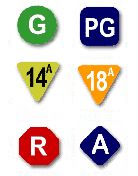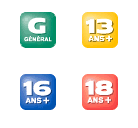Canadian motion picture rating system
Motion picture ratings in Canada are mostly a provincial responsibility, and each province has its own legislation regarding exhibition and admission. For home video purposes, a single Canadian Home Video Rating System rating consisting of an average of the participating provincial ratings is displayed on retail packages, although various provinces may have rules on display and sale, especially for the R and A categories.
There are currently six film classification offices rating movies in Canada, each an agency of a provincial government:
- British Columbia Film Classification Office
- Alberta Film Ratings
- Manitoba Film Classification Board
- Ontario Film Review Board
- Régie du cinéma du Québec
- Maritime Film Classification Board – run by the Nova Scotia Alcohol & Gaming Authority, it provides ratings for Nova Scotia, New Brunswick and Prince Edward Island (and some theatres in Newfoundland and Labrador though it is not compulsory).
The province of Saskatchewan has a Film and Video Classification Board, but since 1997, it uses ratings provided by British Columbia. Newfoundland has no classification office or system. "Newfoundland theatres and video store operators are not required by legislation to use ratings, many theatres in Newfoundland use the classifications assigned by the Maritime Film Board in Nova Scotia".[1] Of the three Canadian territories, Yukon uses the BC ratings, while Nunavut and the Northwest Territories use Alberta ratings.
Canadian ratings outside Quebec

In the past there was a wide range of rating categories and practices in the various provinces. However, the five rating systems outside Quebec now all use categories and logos derived from the Canadian Home Video Rating System.[2][3][4][5][6] In general, the categories are:
- G – General Audience – Suitable for all ages.
- PG – Parental Guidance – Parental guidance advised. There is no age restriction but some material may not be suitable for all children.
- 14A – 14 Accompaniment – Persons under 14 years of age must be accompanied by an adult.
- 18A – 18 Accompaniment – Persons under 18 years of age must be accompanied by an adult. In the Maritimes & Manitoba, children under the age of 14 are prohibited from viewing the film.
- R – Restricted – Admittance restricted to people 18 years of age or older.
- A – Adult – Admittance restricted to people 18 years of age or older. Sole purpose of the film is the portrayal of sexually explicit activity and/or explicit violence. In Alberta, the A category is used only for sexually explicit products. Manitoba and Ontario do not have this category, Manitoba uses a barcode labelling system for Adult home videos while Ontario has a Restricted-Adult Sex (RX) rating for home video products. In British Columbia, the A symbol is a red octagon rather than a blue diamond.
This system was adopted by Alberta and British Columbia in 1997. Manitoba and Ontario adopted it in 2003 and the Maritimes adopted it in April 2005.
There is also a common stock of Information Pieces ("Frightening Scenes", "Coarse Language", etc.),[7] although different boards may have additional qualifiers.
Each board is responsible for assigning a rating to films, and while most movies will likely obtain the same rating, there can be differences. For instance, the film The Texas Chainsaw Massacre: The Beginning was rated 18A in Alberta, British Columbia and Ontario while Manitoba and the Maritimes gave the film an R and Quebec gave the film a 16+ (it was R in the USA).
Canada receives much American advertising concerning film ratings. The American MPAA "R" rating is similar to the Canadian "18A" category (under-18s admitted with adult accompaniment). The Canadian "R" category would be similar to the American NC-17 rating.
Quebec system

In Quebec, the Régie du cinéma rates all films and videos. The Régie is a governmental agency overseen by the Quebec Ministry of Culture and Communications. Its purview devolves from the Cinema Act (RSQ, C-18.1). Individual ratings and their rationales are publicly available online on the Régie's website . The same classifications are used for television broadcasts.
The ratings and their optional complementary indications are as follows:[8]
- G Visa général (General Rating): May be viewed, rented or purchased by people of all ages.
- 13+ 13 ans et plus (13 years and over): May be viewed, rented or purchased by people 13 years of age or over. Children under 13 may be admitted only if accompanied by an adult.
- 16+ 16 ans et plus (16 years and over): May be viewed, rented or purchased by people 16 years of age or over.
- 18+ 18 ans et plus (18 years and over): May be viewed, rented or purchased by adults 18 years of age or over.
While not a classification per se, educational or pedagogical movies, sport and physical exercise programs, and promotional materials are exempt from classification.[9]
The Régie does not cut sequences from movies; they are rated in the format provided by the production company. Nonetheless, the Régie has the authority to deny classification,[9] in which case the movie cannot be distributed in any format in the province of Quebec. Such movies usually feature inhumane sexual exploitation.
Criticism
In certain provinces in Canada, the rating system has come under criticism as being too lenient. For example, in British Columbia, the film Scary Movie was given an 18A rating, but was re-rated on appeal by the Motion Picture and Liquor Appeal Board to a 14A. This resulted in a record number of complaints to the British Columbia Film Classification Office from parents who felt the film should have been rated 18A. Many parents wrote letters to their local newspaper warning others that the film may be inappropriate for their fourteen-year-olds. Theatre owners complained about the inappropriate rating as well.[10]
In British Columbia and Ontario, the Restricted rating is used almost exclusively for films which contain explicit sex. For this reason, with the adoption of the current rating system, many theatres refuse to book R rated films.
See also
- Motion Picture Association of America film rating system
- Entertainment Software Rating Board, the video game equivalent used in Canada and the United States
References
- ↑ "Newfoundland and Labrador Film Classification". Media Awareness Network. Retrieved 2007-12-01.
- ↑ "Alberta Film Ratings". Alberta Ministry of Tourism, Parks, Recreation and Culture. Retrieved 2007-12-01.
- ↑ "classification categories". BC Film Classification. Business Practices & Consumer Protection Authority of British Columbia. Archived from the original on 2007-11-11. Retrieved 2007-12-01.
- ↑ "Film and Video Ratings". Manitoba Film Classification Board. Retrieved 2007-12-01.
- ↑ "Rating Guidelines". Nova Scotia Ministry of Environment and Labour, Alcohol & Gaming Division. 2005-08-02. Retrieved 2007-12-01.
- ↑ "Classification Categories and Content Advisories". Ontario Film Review Board. 2007-11-06. Retrieved 2007-12-01.
- ↑ "The 15 Information Pieces & Definitions". CMPDA. Retrieved 2007-12-01.
- ↑ "Régie du cinéma, Classification Process". Gouvernement du Québec. 2007-12-17. Retrieved 2008-12-24.
- ↑ 9.0 9.1 "Cinema Act (RSQ, C-18.1)". Gouvernement du Québec. 2008-12-15. Retrieved 2008-12-24.
- ↑ Pelton, Steven (2004-08-19). "RECONSIDERATION DECISION: GOING THE DISTANCE requested by Odeon Films" (PDF). British Columbia Film Classification Office. Archived from the original on 2007-09-27. Retrieved 2007-12-01.
| ||||||||||